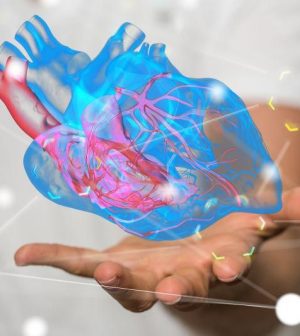- Skip Storing This Everyday Product in the Fridge Door
- Green Tea + B3 Pairing May Boost Brain Health
- Navigating Your Midlife Crisis: Embracing New Possibilities
- City Raccoons Showing Signs of Domestication
- Mapping the Exposome: Science Broadens Focus to Environmental Disease Triggers
- One Week Less on Social Media Linked to Better Mental Health
- Your Brain Changes in Stages as You Age, Study Finds
- Some Suicide Victims Show No Typical Warning Signs, Study Finds
- ByHeart Formula Faces Lawsuits After Babies Sickened With Botulism
- Switch to Vegan Diet Could Cut Your Greenhouse Gas Emissions in Half
Many Stroke Survivors Have Ongoing Irregular Heart Rhythms

About 20% of people who survive what’s called an ischemic stroke have irregular heart rhythms, which can lead to another stroke, researchers say.
But in cases where the stroke was caused by hardening of the arteries, patients aren’t adequately monitored for atrial fibrillation (a-fib, the most common heart rhythm abnormality) after discharge, said lead study author Dr. Lee Schwamm, a professor of neurology at Harvard Medical School, in Boston.
“Relying on routine monitoring strategies is not sufficient and neither is placing a 30-day continuous monitor on the patient. Even if fibrillation is ruled out in the first 30 days, most of the cases are missed — because, as we found, more than 80% of the episodes are first detected more than 30 days after the stroke,” he explained in an American Stroke Association news release.
The three-year study followed a subset of ischemic stroke survivors — specifically, people with narrowing of the arteries (atherosclerosis) that caused a blood clot in the brain. The research did not include people whose blood clot originated in the heart.
Cardiac monitors frequently detected irregular rhythms (a-fib) lasting more than 10 minutes, Schwamm said
“It’s important to note that 6 minutes of atrial fibrillation significantly increases risk of stroke,” Schwamm said.
“We know that about 25% of ischemic strokes happen in patients who have survived a previous stroke,” said Schwamm. “This drives our quest to understand not just the cause of the most recent stroke, but also their risk for future strokes due to all treatable causes, so we can do our best to prevent the next one.”
Schwamm said unrecognized a-fib may increase the risk of a subsequent stroke caused by a blood clot formed in the heart that travels to the brain.
The study included nearly 500 ischemic stroke survivors with no diagnosis of a-fib. Their average age was 67.
Half received an insertable cardiac monitor that recorded their heart rhythms 24 hours a day for three years.
The other half received standard medical treatment, which did not include continuous heart monitoring. They received follow-up care every six months for three years.
The continuous cardiac monitoring device detected a-fib in more than 20% of the participants during those three years. In standard care, this was detected in just 2.5% of patients.
About half of the patients whose a-fib was detected using the monitor had an episode for 10 minutes or more, the findings showed. More than two-thirds of those had an episode lasting greater than one hour.
“We found that the rate of atrial fibrillation continued to increase over the course of the three years, therefore it’s not just a short-lived event and self-resolving related to the initial stroke,” Schwamm said.
While symptoms of atrial fibrillation may include heart palpitations, dizziness, fatigue, chest pain and shortness of breath, more than 80% of patients in the study had no symptoms. Their a-fib was captured on the monitor, Schwamm said.
The study was funded by Medtronic, which manufactures the monitoring device. The findings will be presented this week at a meeting of the American Stroke Association. Findings presented at medical meetings should be considered preliminary until published in a peer-reviewed journal.
More information
The U.S. National Library of Medicine has more on ischemic stroke.
SOURCE: American Stroke Association, news release, Feb. 8, 2023
Source: HealthDay
Copyright © 2025 HealthDay. All rights reserved.










